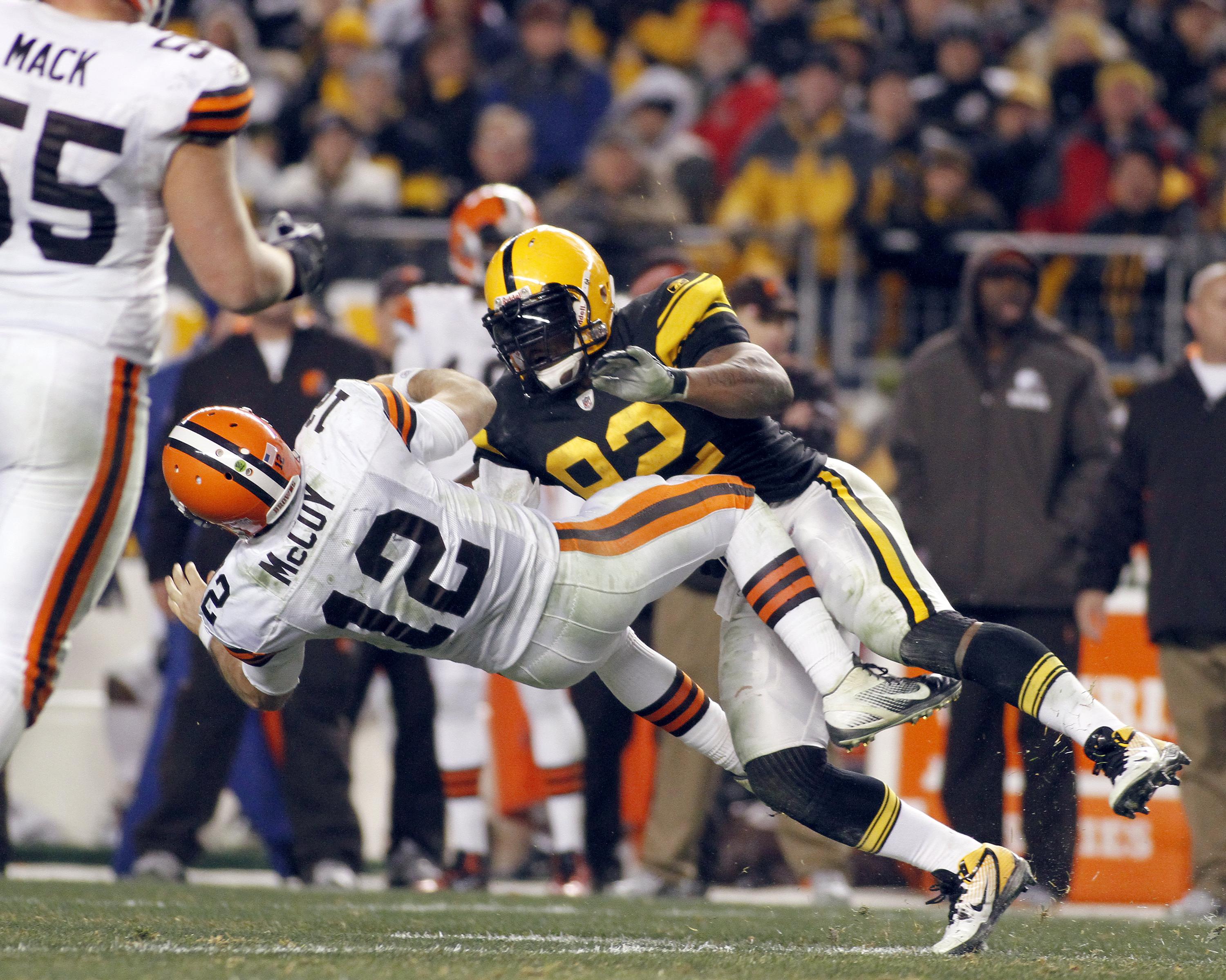This week’s big story (non-Tebow division) is also about what the NFL does and doesn’t want us to see. On Tuesday, the league office suspended the Steelers’ James Harrison for one game for his helmet-to-helmet demolition of Browns quarterback Colt McCoy. The Pittsburgh linebacker, who’s been fined six times for various maulings over the last two seasons, is the first player to be suspended since the league started threatening its players with “enhanced discipline” for illegal hits. From the NFL’s perspective, there could be no better bogeyman.
Harrison is an unrepentant recidivist, a guy who whines about the unfairness of rules designed to protect players from dismemberment. Rather than apologize or at least acknowledge McCoy’s frightening injury, Harrison responded to his suspension by tweeting “LOL!” and saying, “If I would have really hit [McCoy], I would have close to knocked him out.” The Steelers’ defensive star also doubles as a race-baiting, gay-slur-dropping jackass. Plus, the man is just plain scary. Harrison can take any random pose—say, standing against a black background with an FN Five-seven pistol and a Smith & Wesson 460V revolver across his naked, hypertrophied pecs—and make it look menacing.
Roger Goodell wants us to think this angry, unapologetic, gun-toting jerk is the reason pro football is, on occasion, violent and unsafe. But the uneasy reality is that James Harrison doesn’t make the NFL dangerous. Football makes the NFL dangerous. And it’s dangerous on every play, not just those infrequent instances when Harrison gives some quarterback’s brain a bumper-car ride around his skull.
In the last year, the commissioner’s office has largely succeeded in focusing the conversation about football and brain trauma on knockout blows like Harrison’s. Each time a big helmet-to-helmet hit pops up on Sunday, fans in the stadium go silent, columnists say the game has to change, and even some players say that fines are warranted. This obsessive focus on the weekly car crashes in the secondary and the backfield obscures the routine traumas that Nate writes about—the ritual pummeling of the punt-team gunner, for instance. Even more overlooked are the sub-concussive blows that go thudding up and down the offensive and defensive lines, snap after snap after snap. It’s these repetitive knocks to the head, not the show-stopping hits compiled on YouTube, that represent the biggest threat to players’ long-term health.
Consider the fate of Lew Carpenter, a former running back with the Lions, Browns, and Packers, who died last year at the age of 78. Last week, it was learned that Carpenter—though he had never had an officially diagnosed concussion—had an advanced form of chronic traumatic encephalopathy. “Even if he didn’t have any concussions,” one CTE researcher told the Associated Press, “the amount of subconcussive trauma that he had—he probably had between 1,000 and 1,500 subconcussive blows a year, just from practice and play in games.” You can minimize reps on the practice field, but you can’t eliminate in-game, helmet-to-helmet contact at the line of scrimmage.
In late October, Chargers guard Kris Dielman stayed in a game against the Jets after he “wobbled and appeared disoriented” following a big hit. On the team flight after the game, Dielman had a seizure. He’s since been placed on injured reserve. “It really was an unfortunate event, but this is a process and an opportunity to further strengthen our protocol,” the NFLPA’s medical director Dr. Thomas Mayer told ESPN’s Chris Mortensen. “There are a lot of lessons to be learned here.”
Dielman’s seizure kicked up some chatter, but it wasn’t enough to scare the NFL straight. Almost two months later, none of the proposals discussed in the aftermath of the lineman’s concussion—placing independent neurologists on the sidelines of every NFL game, for one—has been implemented.
I’m guessing the McCoy hit will change that. Rule changes come when quarterbacks, not linemen, get planted into the turf. Last Thursday night, McCoy returned to the field just a few plays after Harrison knocked him stiff. “He never should’ve gone back in the game,” McCoy’s dad said afterward, explaining that the next day his son couldn’t remember what had happened. The Browns’ medical staff, amazingly, didn’t check the quarterback for a concussion. According to John Madden, the team’s treatment of McCoy was “wrong in every way.”
On account of Cleveland’s recklessness, those independent neurologists will likely soon be on the sidelines. Though this is long overdue and absolutely necessary, it’s hard to see how such a move would’ve helped, say, Lew Carpenter. The players we should worry about are the ones who don’t appear on a highlight reel or an injury report or underneath James Harrison—the tackles and guards bashing each other on every snap, the fullbacks incurring tiny, unnoticed traumas on every block. What new policy will save these guys from CTE? Players will keep ramming into each other for as long as the NFL exists, no matter how many fines Roger Goodell levies.
